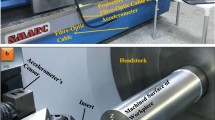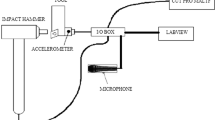Abstract
Regenerative chatter vibrations generally limit the achievable material removal rate in machining. The diffusion of spindle speed variation (SSV) as a chatter suppression strategy is mainly restricted to academy and research centers. A lack of knowledge concerning the effects of non-stationary machining is still limiting its use in real shop floors. This research is focused on the effects of spindle speed variation technique on tool duration and on wear mechanisms. No previous researches have been performed on this specific topic. Tool wear tests in turning were carried out following a factorial design: cutting speed and cutting speed modulation were the investigated factors. The carbide life was the observed process response. A statistical approach was used to analyze the effects of the factors on the tool life. Moreover, the analysis was extended to the wear mechanisms involved during both constant speed machining and SSV. The worn-out carbide surfaces were examined under a scanning electron microscope equipped with an energy dispersive X-ray spectrometer. Significant differences were appreciated. It was observed that SSV tends to detach the coatings of the inserts, entailing a mechanism that is quite unusual in wet steel turning and thus fostering the wear of the tool. The performed analysis allowed to deduce that the intensified tool wear (in SSV cutting) is mainly due to thermo-mechanical fatigue.
Similar content being viewed by others
References
Altintas Y, Weck M (2004) Chatter stability of metal cutting and grinding. CIRP Ann Manuf Technol 53(2):619–642
Kayhan M, Budak E (2009) An experimental investigation of chatter effects on tool life. Proc IME B J Eng Manufact 223(11):1455–1463
Siddhpura M, Paurobally R (2012) A review of chatter vibration research in turning. Int J Mach Tools Manuf 61:27–47
Inamura T, Sata T (1974) Stability analysis of cutting under varying spindle speed. CIRP Ann 23(1):119–120
Yilmaz A, AL-Regib E, Ni J (2002) Machine tool chatter suppression by multi-levelrandom spindle speed variation. Trans ASME J Manuf Sci Eng 124(2):208–216
Insperger T, Schmitz T, Burn TJ, Stépán G (2003) Comparison of analytical and numerical simulations for variable spindle speed turning. Proceedings of IMECE’03 International Mechanical Engineering Congress, Washington, D.C., United States:1-7
Radulescu R, Kapoor SG, DeVor RE (1997) An investigation of variable spindle speed face milling for tool-work structures with complex dynamics, part 1: simulation results. Trans ASME J Manuf Sci Eng 119:266–272
Jayaram S, Kapoor SG, DeVor RE (2000) Analytical stability analysis of variable spindle speed machining. Trans ASME J Manuf Sci Eng 122:391–397
Insperger T, Stépán G (2004) Stability analysis with periodic spindle speed modulation via semidiscretization. J Vib Control 10:1835–1855
Zatarin M, Bediaga I, Munoa J, Lizarralde R (2008) Stability of milling processes with continuous spindle speed variation: analysis in the frequency and time domains, and experimental correlation. CIRP Ann 57:379–384
Albertelli P, Musletti S, Leonesio M, Bianchi G, Monno M (2012) Spindle speed variation in turning: technological effectiveness and applicability to real industrial cases. Int J Adv Manuf Technol 62(1):59–67
Montgomery DC (2001) Design and analysis of experiment, 5th edn. Wiley, New York
Albertelli P, Mussi V, Ravasio C, Monno M (2012) An experimental investigation of the effects of spindle speed variation on tool wear in turning. Process Mach Interact Conf Procedia CIRP 4:29–34
Che Haron CH, Ginting A, Goh JH (2001) Wear of coated and uncoated carbides in turning tool steel. J Mater Process Technol 116(1):49–54
Dearnley PA (1985) Rake and flank wear mechanism of coated and uncoated cemented carbides. J Eng Mater Technol 107:68–82
Chubb JP, Billingham J (1980) Coated cutting tools—a study of wear mechanisms in high speed machining. Wear 61:556–559
Nouari M, Ginting A (2006) Wear characteristics and performance of multi-layer CVD-coated alloyed carbide tool in dry end milling of titanium alloy. Surf Coat Technol 200(18–19):5663–5676
Jawaid A, Sharif S, Koksal S (2000) Evaluation of wear mechanisms of coated carbide tools when face milling titanium alloy. J Mater Process Technol 99(1–3):266–274
Ginting A, Nouari M (2006) Experimental and numerical studies on the performance of alloyed carbide tool in dry milling of aerospace material. Int J Mach Tools Manuf 46(7–8):758–768
Abdel-Aal HA, Nouari M, Mansori M (2009) Tribo-energetic correlation of tool thermal properties to wear of WC-Co inserts in high speed dry machining of aeronautical grade titanium alloys. Wear 266(3–4):432–443
Nouari M, Abdel-Aal HA, El Mansori M (2006) Analysis of coating delamination under extreme contact loading. Tribol Lett 23:39–45
Grzesik W (1999) Experimental investigation of the cutting temperature when turning with coated indexable inserts. Int J Mach Tools Manuf 39(3):355–369
Chiappini E, Tirelli S, Albertelli P, Strano M, Monno M (2014) On the mechanics of chip formation in Ti6Al4V turning with spindle speed variation. Int J Mach Tools Manuf 77:16–26
Author information
Authors and Affiliations
Corresponding author
Rights and permissions
About this article
Cite this article
Albertelli, P., Mussi, V. & Monno, M. The analysis of tool life and wear mechanisms in spindle speed variation machining. Int J Adv Manuf Technol 72, 1051–1061 (2014). https://doi.org/10.1007/s00170-014-5736-4
Received:
Accepted:
Published:
Issue Date:
DOI: https://doi.org/10.1007/s00170-014-5736-4




